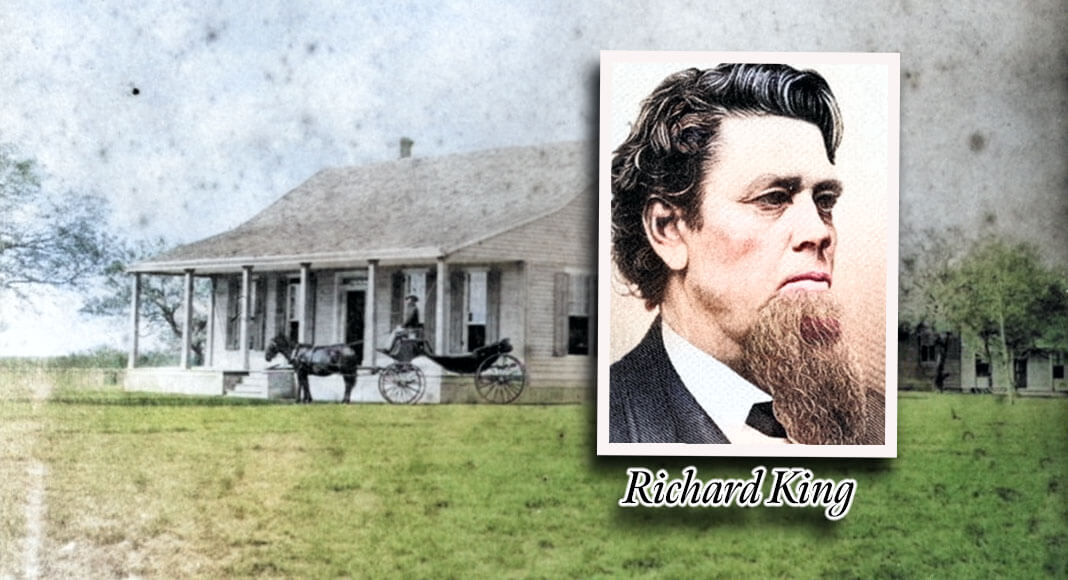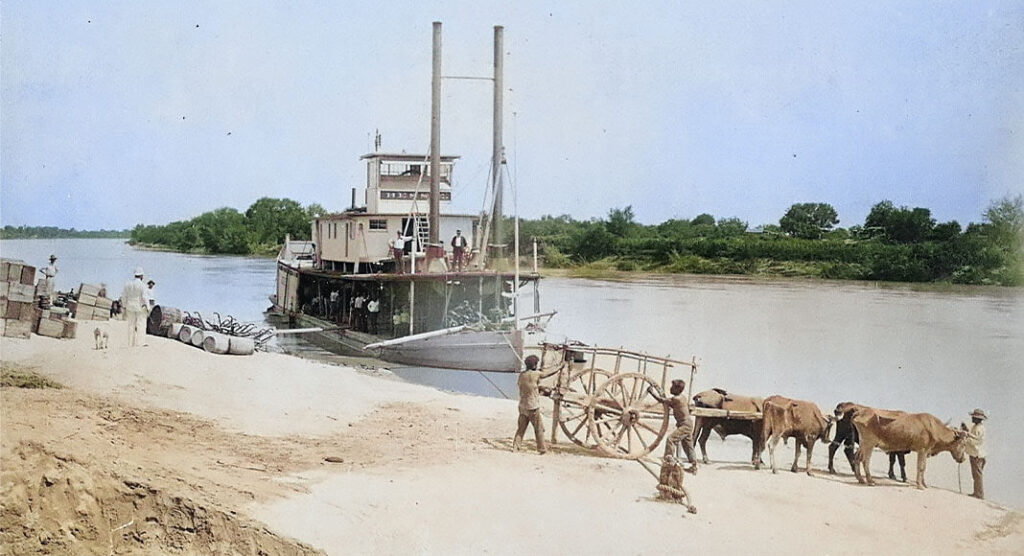
RICHARD KING – (1824–1885). Riverman, steamboat entrepreneur, livestock capitalist, and founder of the King Ranch, was born in New York City on July 10, 1824, to poor Irish parents. He was reared in Orange County, New York, until age nine, when he was indentured to a jeweler in Manhattan. He broke his apprenticeship in 1835 and shipped as a stowaway on the Desdemona for Mobile, Alabama. King was discovered, taken in as a “cabin cub,” and schooled in the art of navigation by captains Hugh Monroe and Joe Holland. Between 1835 and 1841, with the exception of eight months of formal schooling with Holland’s family in Connecticut, King pursued steamboating on Alabama rivers; he was a pilot by age sixteen. In 1842 he enlisted under Capt. Henry Penny for service in the Seminole War in Florida, where he met Mifflin Kenedy, who became his lifelong friend and business mentor. King plied the muddy waters of the Apalachicola and Chattahoochee rivers until 1847, when he joined Kenedy on the Rio Grande for Mexican War service. Commanding the Colonel Cross, he served for the war’s duration transporting troops and supplies.

King remained on the border after the war and became a principal partner in the steamboat firms of M. Kenedy and Company (1850–66) and King, Kenedy and Company (1866–74). These firms dominated the Rio Grande trade on a nearly monopolistic scale for longer than two decades. By all accounts King was an experienced riverboatman and a hardy risk-taker, who thought that he could take a boat anywhere “a dry creek flows.” He was also an innovator who designed specialty boats for the narrow bends and fast currents of the Rio Grande. Perhaps most of all, he was a hardened speculator, a businessman in the classic nineteenth-century mold; he saw business as having no social responsibilities, only profitable ones. As a result, he had his hand in many pies with as many different associates. And of course the big pie in South Texas in the early 1850s was undeveloped land.
King began speculating in Cameron County lands and in lots in the new town of Brownsville soon after his arrival on the Rio Grande. As his cash flow increased from the success of his steamboat interests, he invested further in lands in the Nueces country. He learned early about the pitfalls of buying Spanish and Mexican titles by purchasing in 1852 what turned out to be a bogus claim to the southern half of Padre Island. From that time forward, he paid careful attention to the legality of land transactions, and almost all of his subsequent land acquisitions were made through his lawyers, Stephen Powers, James B. Wells, and Robert J. Kleberg. In several partnerships, King first bought land in the Nueces Strip in 1853, when he purchased the 15,500-acre Rincón de Santa Gertrudis grant from the heirs of Juan Mendiola, who held the land under an 1834 grant from the state of Tamaulipas, Mexico. In 1854 he purchased the 53,000-acre Santa Gertrudis de la Garza grant from José Pérez Rey, who held title under an 1808 grant from the crown of Spain. These two irregularly shaped pieces of wilderness became the nucleus around which the King Ranch grew. By the time of his death in 1885, King had made over sixty major purchases of land and amassed some 614,000 acres.
With partners James Walworth and Mifflin Kenedy, King established a livestock concern, R. King and Company, to manage the holdings, and he moved off the Rio Grande to the Nueces rancho in late 1860 to develop the ranching business. During the Civil War he and his partners entered into several contracts with the Confederate government to supply European buyers with cotton; in return they supplied the Confederates with beef, horses, imported munitions, medical supplies, clothing, and shoes. By placing their steamboat interests under Mexican registry and moving their operations into Matamoros, they for the most part successfully avoided the Union blockade and earned considerable fortunes. In an attempt to dampen this trade, Union forces captured Brownsville in late 1863 and raided the King Ranch, looting and destroying most of it on December 23. King, however, escaped before the raid and resumed business anew after the Confederates under John S. (Rip) Ford reclaimed South Texas in 1864. King went to Mexico at the war’s end and returned after securing his pardon from President Andrew Johnson in late 1865.
He and Kenedy dissolved their partnership in 1868 and became individual proprietors, King ranching at Santa Gertrudis and Kenedy at Los Laureles. They went on to build two of the most famous ranches in the American West. Flush with war profits, they revolutionized the economics of South Texas ranching with the introduction of fencing, cattle drives to northern markets, large-scale cattle, sheep, mule, and horse raising, and the scientific breeding of livestock. Between 1869 and 1884 King sent more than 100,000 head of livestock up the trails to northern markets, thus helping to stock the developing ranges of the American West and to establish the American ranching industry.
He brought raw American capitalism to his ranching effort. Rather than reinvent the wheel, he built his ranch on the hacienda system, which had been established in South Texas for centuries. He adopted the Hispanic legacy of patrón-peón “feudal” rule because it provided reliable and cheap labor; management positions at King Ranch were reserved for non-Hispanic lieutenants. King’s access to capital fueled his never-ending expansion in land and livestock. This allowed him to displace competing ranchers and landowners, both Anglo and Mexican. He believed vehemently in the concept of private property, which of course was incompatible with the open range. Consistent with his belief, he particularly despised squatters and treated them accordingly. He utilized armed force, not always legally deputized, to protect his interests against outlaw elements. He invested heavily in railroads (especially the Corpus Christi, San Diego, and Rio Grand Narrow Gauge Railroad), packing houses, ice plants, and harbor improvements at Corpus Christi, and attempted to integrate his livestock business with his other concerns. He earned a fortune because he foresaw the development of a market for his commodity, procured volume production, and attempted to control transportation and markets.
When King died at the Menger Hotel in San Antonio, he left a last instruction to his lawyer, “Not to let a foot of dear old Santa Gertrudis get away.” As an Irish pioneer rancher in Hispanic South Texas, King acquired the traits of an hacendado—a paternalistic bond with his vaqueros, an identification with the ranch, and an obsession to expand landholdings. Yet he was also a product of his time, the age of manifest destiny. His name is linked to several revolutionary and filibustering efforts to form separate territories out of northern Mexico. In a letter written in 1894 to Robert Kleberg, Kenedy reminisced that “for almost fifty years, Captain King and I attempted to Americanize the border, without much success.” On December 10, 1854, at Brownsville, King married Henrietta M. Chamberlain, who survived him and died at Santa Gertrudis on March 31, 1925. They had five children. King died on April 14, 1885, and was buried at San Antonio. In 1925 his body was reburied with his beloved wife’s at Kingsville, the town established on his ranchland in 1904 and named for him.
Biography by Bruce S. Cheeseman, Handbook of Texas Online
Published by the Texas State Historical Association















